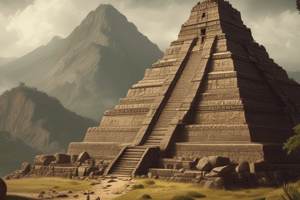Podcast
Questions and Answers
What was the purpose of creating paired keros in Inka society?
What was the purpose of creating paired keros in Inka society?
To convey the sense of equality and intimate bond.
The mitmaq involved relocating people based on their skills and knowledge.
The mitmaq involved relocating people based on their skills and knowledge.
True (A)
Which of the following crops were produced through the mitmaq system? (Select all that apply)
Which of the following crops were produced through the mitmaq system? (Select all that apply)
- Rice
- Chili Peppers (correct)
- Maize (correct)
- Coca (correct)
What was the major road system of the Inka Empire called?
What was the major road system of the Inka Empire called?
What was a significant achievement of the Inka in relation to their road system?
What was a significant achievement of the Inka in relation to their road system?
The ___ served as the nerve system of the Inka Empire.
The ___ served as the nerve system of the Inka Empire.
What was the role of the chaski in the Inka Empire?
What was the role of the chaski in the Inka Empire?
The Inka Empire's road system only included roads without any support facilities.
The Inka Empire's road system only included roads without any support facilities.
What was one function of the mitmaq apart from producing crops?
What was one function of the mitmaq apart from producing crops?
What were the staple crops of the Inka adapted to high elevations?
What were the staple crops of the Inka adapted to high elevations?
What was maize primarily used for in the Inka Empire?
What was maize primarily used for in the Inka Empire?
The Inka primarily utilized maize as a staple food similar to modern consumption.
The Inka primarily utilized maize as a staple food similar to modern consumption.
What were the vessels used for drinking during rituals in the Inka Empire called?
What were the vessels used for drinking during rituals in the Inka Empire called?
What did the Inka rely on to facilitate large-scale agriculture?
What did the Inka rely on to facilitate large-scale agriculture?
What were the main materials used in Inka art and crafts?
What were the main materials used in Inka art and crafts?
Inka art was known for its chaotic and irregular style.
Inka art was known for its chaotic and irregular style.
What unique architectural technique did the Inka use?
What unique architectural technique did the Inka use?
What was unique about the trapezoidal doors and windows in Inka architecture?
What was unique about the trapezoidal doors and windows in Inka architecture?
The major sites of Cusco and Huánuco Pampa were configured to form royal symbols of the ______ and ______.
The major sites of Cusco and Huánuco Pampa were configured to form royal symbols of the ______ and ______.
What type of service did commoners provide to meet the demands of the Inka Empire?
What type of service did commoners provide to meet the demands of the Inka Empire?
What was the purpose of sharing drinks like aqha or chicha during Inka political gatherings?
What was the purpose of sharing drinks like aqha or chicha during Inka political gatherings?
What is Tawantinsuyu?
What is Tawantinsuyu?
The Inka Empire had a writing system.
The Inka Empire had a writing system.
Who was Pedro Cieza de León?
Who was Pedro Cieza de León?
What is khipu?
What is khipu?
Which of the following crops did the Inkas intensify cultivation of?
Which of the following crops did the Inkas intensify cultivation of?
What was the main sacred area of Cusco called?
What was the main sacred area of Cusco called?
The Inka ruler was believed to be a son of the sun deity, Inti.
The Inka ruler was believed to be a son of the sun deity, Inti.
What is the significance of the Qorikancha Temple?
What is the significance of the Qorikancha Temple?
Match the following Inka rulers to their roles:
Match the following Inka rulers to their roles:
Flashcards are hidden until you start studying
Study Notes
Overview of Inka Culture and Empire
- Tawantinsuyu translates to "the unity of the four parts" in Quechua, designating the Inka Empire's territory.
- Inka studies are multidisciplinary, involving scholars from at least 20 countries across various fields such as archaeology, history, and ethnography.
- The Inka culture lacked a writing system, with early knowledge relying on chronicles written by Spanish chroniclers after the Spanish conquest (ca. 1532-35 CE).
Key Chronicles and Chroniclers
- Pedro Cieza de León documented the Inka Empire shortly after the conquest, providing insights into their geography and lifestyle.
- Juan de Diez de Betanzos, a Spanish translator married to an Inka royal, recorded valuable perspectives on Inka leadership and customs.
- Chronicles differ in reliability, influenced by timing and authors’ biases, yet remain essential resources for understanding Inka history.
Khipu as a Record-Keeping Tool
- Inka utilized khipu, a knotted cord system, for numeric and non-numeric data recording; decoding efforts remain incomplete.
- Recent archaeological discoveries in sites such as Cusco and the Sacred Valley support and enhance the information found in historical chronicles.
Origins and Dynastic History
- Inka roots trace back to the south shore of Lake Titicaca, with migration leading to the establishment of Cusco.
- Traditional accounts cite 11 or 12 kings; however, recent interpretations suggest the lineage was more complex and competitive.
- Archaeological evidence suggests the Inka Empire's formation involved gradual alliances rather than military conquests, particularly under Pachacuti Inka Yupanqui (1438-1471 CE).
The Capital: Cusco
- Cusco, at 3,400 meters above sea level, functioned as the political, ceremonial, and geographical center of the Empire, symbolizing the Inka worldview.
- Drought conditions in the 13th century inspired urban agricultural advancements and political centralization in Cusco.
- The city's layout emulated a stylized puma shape and housed significant religious and governance structures, including Qorikancha—the Temple of the Sun.
Inka Rulers and Religion
- The Sapa Inka was viewed as a divine figure, the son of the sun god Inti, central to maintaining cosmic balance and the Empire's stability.
- The cult of ancestors and worship of the sun were fundamental to Inka identity, with royal mummies revered as part of royal lineage stability.
- In addition to sun worship, provincial deities such as Pachamama (Mother Earth) and various huacas (sacred objects or places) played significant roles in regional religious practices.
Inka Agriculture
- Agriculture was integral to Inka life, with importance on staple crops adapted for high elevations, such as potatoes and quinoa.
- Maize served as the primary ceremonial crop, used to make chicha, a sacred beverage consumed during rituals and gatherings.
- Agricultural practices involved extensive terraces and water management systems, ensuring productivity and sustaining the Empire's socio-economic structure.### Agriculture and Innovation
- Inka farmers were relocated across the Empire to enhance agricultural practices.
- Established agricultural experimental stations analyzed soil, temperature, and sunlight to optimize crop sowing times.
- Collected data was likely encoded in khipus for widespread dissemination across the Empire.
Art and Crafts
- Inka art evolved from thousands of years of previous traditions, showcasing distinct geometric and standardized styles.
- Artisans were relocated to the capital, Cusco, leading to the development of artisan colonies, including potters and metalworkers.
- Inka craftsmanship emphasized visual symbolism representing power, prestige, and generosity, facilitating communication among diverse cultural backgrounds.
Weaving and Textile Production
- Weaving was the Inka Empire's primary artistic focus, producing high-quality cumbi cloth for elites.
- The use of alpaca and vicuña fibers resulted in intricate geometric designs in textiles meant for significant ceremonial and royal purposes.
Metalwork
- Gold and silver craftsmanship held cultural significance, with items symbolically linked to the Sun and Moon.
- Qorikancha, the Sun Temple in Cusco, was adorned with gold, enhancing its reflective brilliance.
Architecture
- Inka constructed diverse buildings, including royal palaces, temples, and storage complexes using ashlar and polygonal masonry techniques.
- Stone masonry was a hallmark of prestige architecture, noted for its precise right-angle corners and without mortar.
- Adobe brick constructions, while less durable, were used extensively in regions susceptible to weather damage.
Symbolism in Architecture
- The iconic trapezoidal openings in Inka buildings symbolized duality in society, reflecting the Inka worldview.
- Inka architecture conveyed power and permanence, integrating with natural landscapes, as seen in Machu Picchu's design.
Daily Life of Commoners
- Commoners primarily engaged in agriculture within kinship-based ayllus, managing land collectively.
- Labor obligations were organized through systems like mi'ta, where common people provided labor in exchange for support and community resources.
- Inka elite's demands led to increased dissatisfaction among commoners, driving a wedge between rulers and subjects.
Diplomacy and Political Strategies
- Inka employed military and psychological tactics to secure loyalty from subjugated populations, including holding sacred items hostage.
- Reciprocity, represented by shared ceremonial drinks and gifts, was a primary means of establishing loyalty and obedience.
Administrative and Economic Systems
- The Inka empire utilized a labor tax (mi'ta) and a population transplantation system (mitmaq) to sustain economic needs.
- Mitmaq involved relocating groups with specific skills to different ecological zones, fostering economic production across the Empire.
Road System
- The extensive Inka road system facilitated the transfer of resources, information, and soldiers, crucial for maintaining the vast Empire.### Inka Road System
- The Inka road system, known as Qhapaq Ñan (Capac Ñan), is recognized for its extensive reach and efficiency, surpassing the Roman roads.
- Covered approximately 40,000 km, spanning from Colombia to southern Chile, eastern Bolivia, and the Pacific coastline.
Integration and Expansion
- The Inka improved and integrated pre-existing regional roads, creating a comprehensive network that was more advanced than the individual components.
- This road system formed the operational backbone of the Inka Empire, facilitating administration and communication.
Road Structure
- Comprised two main parallel routes: a highland road from Cusco to Quito and a coastal road.
- Dozens of lateral roads connected these main routes, enhancing accessibility throughout the Empire.
Communication and Logistics
- Runners, known as chaski, relayed messages across the empire, achieving up to 250 km coverage per day via a relay system.
- Imperial inspectors monitored the maintenance of the road, along with strategically placed administrative centers, corrals for llamas, and storage facilities.
Administrative and Strategic Importance
- Regional administrative centers served as hubs for implementing imperial policies and maintaining Inka presence among subject populations.
- The holistic design of the road and associated installations indicates the Inka's capability for grand-scale planning and administration.
Cultural and Historical Recognition
- The Qhapaq Ñan symbolized the unity of the Inka Empire, linking Cusco to its hinterlands conceptually and physically.
- UNESCO designated the Qhapaq Ñan as a World Heritage Site in 2014 due to its scale, engineering, and cultural significance across six Andean countries: Colombia, Ecuador, Peru, Bolivia, Chile, and Argentina.
Studying That Suits You
Use AI to generate personalized quizzes and flashcards to suit your learning preferences.




